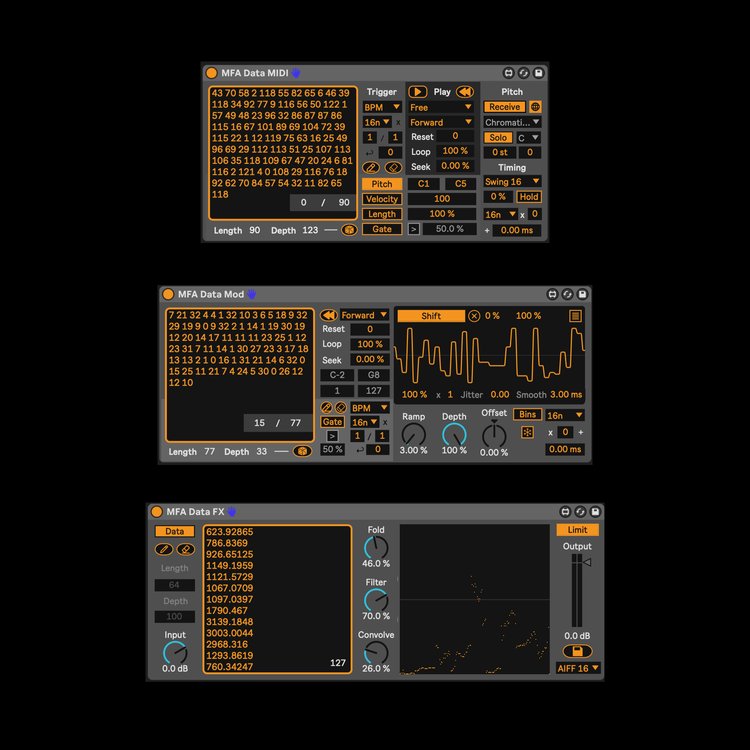Data visualization tools are now numerous, but sonification – transforming information into audio – holds untapped potential. Manifest Audio has a set of tools that makes it uncommonly easy to translate data into MIDI, modulation/control, and sound. You can use data as a creative source – and use music and sound as a way of understanding complex information.
That, in turn, means this could be a gold mine for education, and a way for people whose expertise is music, sound, and Ableton Live to connect with people understanding data – whether that’s climate change or macroeconomics or soil statistics. Of course, it also means that instead of just hooking up another tired triangle wave LFO to your synth, you could power an effect based on how much email you received in the last month or (eek!) your tax data. (Hey, maybe it could be cathartic.)
We saw this kind of creative approach from Manifest Audio and founder/artist Noah Pred before, with Solarus – a free modulation tool that uses accurate solar system data. Now, some of you were unimpressed by that. Well, here’s your chance to do better, if you like – because now you can plug in any data you wish.
The interface for Sonification Tools is straightforward – you just get a text field into which you type or paste numbers directly. But that’s really beginner-friendly as all you need to do is output a string of data points. That means you could use as a source anything from a CSV file to Google Sheets to some text you pasted off a website table. Noah suggests Our World In Data if you’re stuck for ideas.
The field looks small, but you can fit as many as 2048 data points. And I expect that’s a good starting point for a lot of use cases and quick prototypes. (Even if I were building something more advanced, the first thing I would do is try testing with a small subset of the data so I could listen to what happened.)
The fun here is what you can do with the data – and that’s where Noah builds on some of the work he’s done as a Live trainer and inventor of Max for Live devices. You get three dedicated tools in the bundle:

- Data MIDI creates MIDI patterns with pitch and trigger content, including dedicated controls for timing, swing, and pitch mapping.
- Data Mod generates (control-rate) modulation, also with sync/free modes, smoothing and ramping, offset, depth, and randomization, among other tweakable details.
- Data FX translates data directly into sound, with additional wavefolding, filtering, and impulse convolution features, plus audio export.
Okay, so Data FX is where things get really interesting – it translates data points into a table which you can use to output audio, and it’s a spectral filter, impulse convolver, and wavefold distortion on top of it. You then can export AIFF or WAV.
There are some other unique twists to the other two, though, as well – data can be triggered at a millisecond rate for or via MIDI input, too, for fine-grained or live-performed steps through the data points.
Now, of course, there are many other ways to go about this. p5.js for instance, makes it easy to work with the data side and has at least some basic sound tools; you could also use something like that with OSC output to a synth of your choice. And if you’re looking at this wondering what you might do with the same concept in Max for Live, well – hopefully, this encourages you to give it a try!
But I do find the convenience factor here to be a major one. And building some of the rest of the musical tools (like handling tempo information), plus adding other audio effects, means there’s a significant value here – including to beginners who may never have tried this before.
As the headline suggests, it’s not hard for me to imagine teachers using this in an educational environment. I know some educators are reluctant to talk about music in STEM terms, but I see it the other way: I struggled with mathematics and physics as they got more abstract and paper-based, as I’m sure some readers did. Translating to music and sound can make those topics far more accessible and practical. It’s not that music needs to focus on these other topics; it’s that those topics benefit from music and sound.
So, dear fall semester – you’re welcome.
Sonification Tools [manifest.audio]
Live 10+ required, with Suite or a Max for Live license.
And don’t forget to stock up on the free devices while you’re there; I use MOD Squad all the time.
Got experience with other sonification tools? Projects you’ve worked on? I’d love to hear from you in comments.
Let’s get some music in here: By the way, I love that people are finding time to both make machines and tools and make music. Noah quietly let slip this absolute scorcher of a techno track this month, which is a must with or without the context of the Max stuff. This is truly one of my favorite Noah creations. And let’s raise a glass to everyone managing to keep up with production and Maxing and teaching. Use those brains. Kudos.